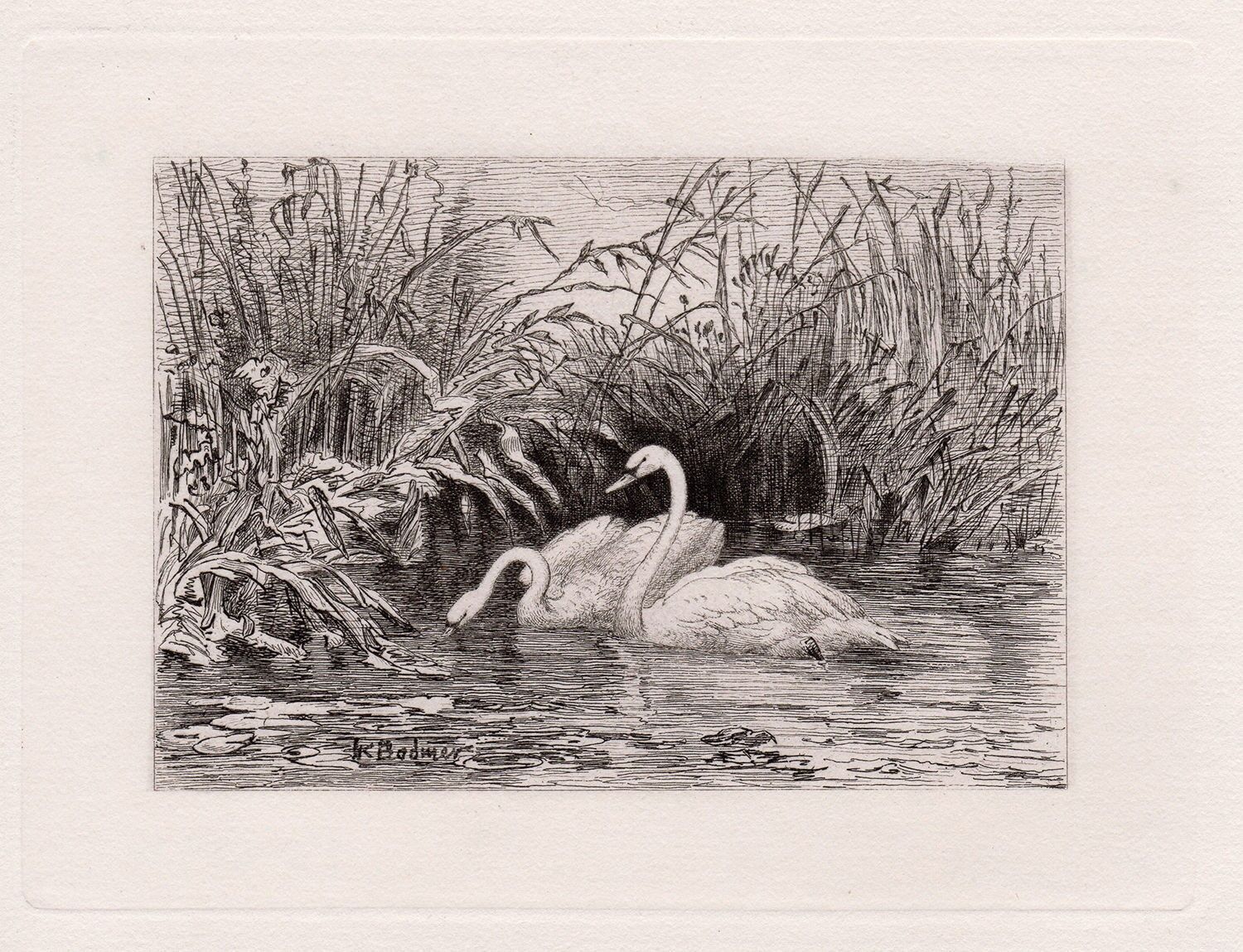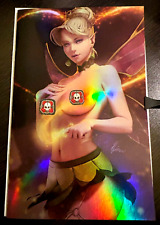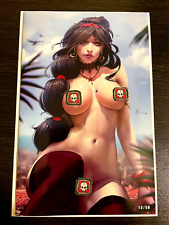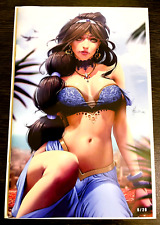Magical Karl Bodmer Original 1800s Etching \"Swans on Swan Lake\" Signed COA Neat For Sale

When you click on links to various merchants on this site and make a purchase, this can result in this site earning a commission. Affiliate programs and affiliations include, but are not limited to, the eBay Partner Network.
Magical Karl Bodmer Original 1800s Etching \"Swans on Swan Lake\" Signed COA Neat:
$244.00
Four Centuries of the world\'s finest artists
from our collection to yours
Thank you for visiting...
Click here for HOT DEALS | Click here for our sales
Artist: Karl Bodmer (Johann Carl Bodmer) (Swiss, 1809-1893)
Title: Swans
Medium:Antique etching on thick laid paper.
Condition: Excellent
Dimensions: Image size 4 5/8 x 6 3/8 inches.
Framed dimensions: Approximately 14 x16 inches.
Framing: This piece has been professionally matted and framed using all new materials.
Additional notes:
This is not a modern print. This is an original Karl Bodmer etching. This impression is more than 140 years old. The strike is crisp and the lines are sharp.Artist Biography:Johann Carl Bodmer was a Swiss-French printmaker, etcher, lithographer, zinc engraver, draughtsman, painter, illustrator and hunter. Known as Karl Bodmer in literature and paintings, as a Swiss and French citizen, his name was recorded as Johann Karl Bodmer and Jean-Charles Bodmer, respectively. After 1843, likely as a result of the birth of his son Charles-Henry Barbizon, he began to sign his works K Bodmer. Karl Bodmer was well known in Germany for his watercolours, drawings and aquatints of cities and landscapes of the Rhine, Mosel and Lahn rivers. After he moved to France following his return from an expedition in the American West, he became a member of the Barbizon School, a French landscape painting group from the mid-19th century. He created many oil paintings with animal and landscape motifs, as well as wood engravings, drawings, and book illustrations. For his work, Bodmer was made a Knight in the French Legion of Honour in 1877. He is best known in the United States as a painter who captured the American West of the 19th century. He painted extremely accurate works of its inhabitants and landscape. He accompanied the German explorer Prince Maximilian zu Wied-Neuwied from 1832 through 1834 on his Missouri River expedition. Bodmer was hired as an artist by Maximilian in order to accompany his expedition and record images of cities, rivers, towns and peoples they saw along the way, including the many tribes of Native Americans along the Missouri River and in that region. Bodmer had 81 aquatints made from his work to illustrate Prince Maximilian\'s book entitled Maximilian Prince of Wied\'s Travels in the Interior of North America (1839-1841 in German/published in English translation in 1843-1844). Johann Carl Bodmer was born on 11 February 1809 in Zurich, Switzerland. When he was thirteen, his mother’s brother, Johann Jakob Meier (a prominent engraver), became Bodmer\'s teacher. Meier was an artist, having studied under the well-known artists Heinrich Füssli and Gabriel Lory. Young Bodmer and his older brother, Rudolf, joined their uncle on artistic travels throughout their home country. By 1828, Bodmer had left his native Switzerland to work as a painter and engraver in the German city of Koblenz. It was there that he and his work came to the attention of Prinz Maximilian zu Wied-Neuwied. This German aristocrat had successfully led a scientific expedition to Brazil in 1815–1817. He decided to embark on another such venture, this time to North America and especially the American West. He hired Bodmer to accompany his expedition and make a visual record of the places and peoples encountered, through painting, drawings, etc. The aristocrat was known popularly to naturalists then and now as Prince Max. After delays, Bodmer, in the company of Prince Max and David Dreidoppel, a huntsman and taxidermist, sailed for North America on 17 May 1832. In a letter of that date, Prince Max wrote to his brother that Bodmer \"is a lively, very good man and companion, seems well educated, and is very pleasant and very suitable for me; I am glad I picked him. He makes no demands, and in diligence he is never lacking.\" Fort Pierre on the Missouri and the adjacent prairies, c. 1833. Aquatint by Bodmer from Maximilian, Prince of Wied’s Travels in the Interior of North America (1843-1844), which his works illustrate. Arriving in Boston, Massachusetts, on 4 July, the three encountered hardships and delays caused largely by a cholera epidemic in the eastern states. It swept across the northern tier to Michigan via travelers on the waterways. The three men finally reached Pittsburgh, and started from there October 8 to travel west along the Ohio River. They arrived in Mt. Vernon, Indiana about midnight on 18 October. The next morning, the party made their way to New Harmony, Indiana. Prince Max had planned to spend only a few days in New Harmony, but his stay \"was prolonged by serious indisposition, nearly resembling cholera, to a four months\' winter residence.\" The Prince devotes a chapter of his book of the expedition to New Harmony and its environs. He featured the work and personalities of Thomas Say and Charles-Alexandre Lesueur, two leading American naturalists. Lesueur was also a prolific artist. Unlike the Prince and Dreidoppel, Bodmer escaped the illness. Alone, he left New Harmony at the end of December, and on 3 January 1833 caught a steamboat at Mt. Vernon, Indiana. He traveled down the Mississippi River to New Orleans, spending a week with Joseph Barrabino. This Italian-American naturalist was a friend of Say and Lesueur. In April 1833, Prince Max and Bodmer set out from St. Louis, Missouri on the 2,500-mile journey by steamboat and later keelboat up the Missouri River. They eventually traveled as far as Fort McKenzie. After wintering at Fort Clark near the Mandan villages, they returned downriver the following spring, having spent more than a year on the Upper Missouri. Bodmer had extensively documented the journey with visual images, while Prince Max took copious notes for the book he intended to write. After completing the expedition, Bodmer returned to Germany with Prince Maximilian, then traveled to France. In Paris he had many of his paintings from the expedition. The Prince had these images incorporated into his book of the expedition, which was first published in German in Koblenz as Reise in das innere Nord-Amerika in den Jahren 1832 bis 1834 in twp volumes from 1839 to 1841. Its English translation, Maximilian Prince of Wied’s Travels in the Interior of North America, during the years 1832–1834, was published in London in 1843-1844. Bodmer moved permanently to Barbizon, France, and became a French citizen. Recorded as Jean-Charles Bodmer, he went by \"Charles Bodmer\". He became a member of the Barbizon School, a group of painters who specialized in landscapes and works featuring animals. He worked in a variety of genres: painting, etching, wood engraving and illustration. Among his well-known works from this period was La Foret en Hiver (Interior of the forest in winter), exhibited at the Salon 1850 in Paris. It was painted at Fontainebleau forest. Bodmer also made an engraving of his painting, and reproductions were popular in the 1860s. Impressionist Claude Monet later painted the same trees, titling his painting The Bodmer Oak. This scene was the subject as well of numerous photographs in the 1870s. The Joslyn Art Museum in Omaha, Nebraska is home to the largest of three known collections of Bodmer\'s watercolors, drawings, and prints. Bodmer captured a challenging and dramatic landscape that was still unfamiliar to audiences in the eastern United States and Europe. His portraits were the first accurate portrayal of western Indians in their homelands, and they are considered remarkable for their careful detail and sensitivity to the personalities of his sitters. To this day, Bodmer\'s work remains one of the most perceptive and compelling visual accounts of the American interior. Bodmer\'s work is recognised as among the most accurate painted images ever made of Native Americans, their culture and artifacts, and of the scenery of the pristine \"Old West\".
Accompanied by a Certificate of Authenticity and is Fully Guaranteed to be Certified as Described
Framing Any framing included in a listing is double matted and framed in a solid wood moulding. We can also frame any pieces not listed as such. Please contact us for pricing. We are usually half the price of a regular framer.Shipping Packages are shipped the next business day after confirmed payment is received. If you are making multiple purchases, please request an invoice so that we may combine shipping charges for you.Guarantee We guarantee all our listings to be 100% as describedReturns Returns are accepted up to fourteen days after receiving your purchase. Buyer accepts responsibility for any additional shipping charges.
| Click here for HOT DEALS | Click here for our sales |

Related Items:
MAD LOVE #7 TINKERBELL KARL LIVERSIDGE EXCLUSIVE TOPLESS FOIL VIRGIN LTD 50 NM+
$199.95
MAD LOVE #1 JASMINE EXCLUSIVE FULL NUDE VIRGIN COVER NUMBERED LTD 50 NM+
$199.95
MAD LOVE #1 JASMINE BLUE DRESS EXCLUSIVE VIRGIN COVER NUMBERED LTD 20 NM+
$199.95



